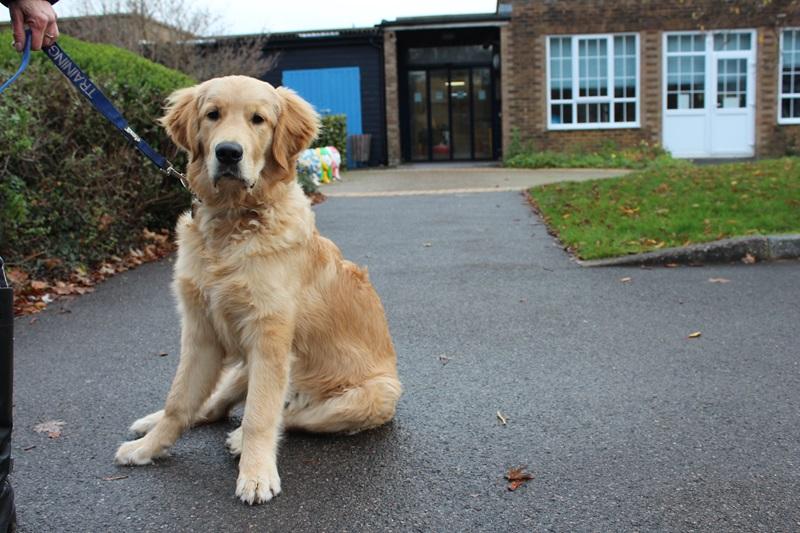
September was a back to school month for both Treloar's students and all student-facing staff. We welcomed back staff after the summer break, but also the new joiners—and one of them was Stanley—the therapy dog.
Stanley joined Treloar's Counselling Team and quite quickly found his feet (or should we say 'paws'?) in the new environment. He has quickly become part of Treloar's, recognised in the corridors, making everyone smile. Stanley will be the first therapy dog to be trained at Treloar's.
Judith Horwell, Specialist Counsellor at Treloar's but also Stanley's owner and trainer, told us how Stanley's training and his journey to become a therapy dog is going.
What is a therapy dog?
A therapy dog is a dog trained to support the well-being of multiple people to provide a temporary support system to people, contributing to creating a warmer and safe environment to help lead people to recovery. A therapy dog seeks to connect with people in a non-judgemental way with unequivocal acceptance.
What will the tasks of a therapy dog be here at Treloar's?
Stanley’s tasks will primarily be to work alongside the counsellor to offer canine assisted therapy for students who will benefit from Stanley’s therapeutic input. Additionally, Stanley may offer planned visits to classes or individuals across the site to support with confidence building, social interaction and strengthening self-esteem of students.
What are the benefits of having a therapy dog on site?
Having a therapy dog on site can offer a supportive, entertaining and stimulating presence for all. Canine therapy can develop an outward focus (which means that students and staff could be paying attention to what’s happening in the external environment instead of internal feelings and stresses) thus reducing felt anxiety, lifting spirits of both students and staff. Therapy dogs can increase nurturing skills and empathy and build confidence and self-esteem. They can be calming and soothing and can help foster kindness. Canine therapy provides opportunities for social interaction and connection thus decreasing feelings of isolation and loneliness. Helping to support psychophysiological health with emotional regulation through mental and/or bodily recognition, which soothes and decreases blood pressure.
What are the criteria for a dog to become a therapy dog?
Certain breeds can be really well suited to therapy dog training but most breeds have the potential so it is really about temperament of the dog. A therapy dog needs to have the right temperament and should be affectionate, friendly and sociable. The dog must be comfortable with noisy environments and lots of touch and contact. It must be relatively calm, obedient and easy to control. It needs to be comfortable in different environments and with being around different people and should enjoy the experience.
What kind of training is required?
There is no formal training requirements as yet in this country, however, setting up without training is not recommended as this is unlikely to be covered by any indemnity insurance providers, which protect both the therapist and public. For those undertaking animal assisted therapy, they do need to be suitably qualified which can be within counselling or some other type of therapy. The recommendations are then that, firstly, the dog and the handler need to undergo a positive dog training programme such as that provided by trainers of the Institute of Modern Dog Trainers. Alongside this, completing a formal therapy dog training programme such as: Paws Therapy Dogs Certification Programme is highly recommended. In addition, it is recommended the handler completes an Animal Assisted Training Course as run by BSY.
When did Stanley start his training and how is it going?
Stanley started formally training from 14 weeks old, however, between 8-14 weeks foundations in training were already being laid. He is doing well with many aspects of his training and has been focusing on becoming used to the environment and feeling comfortable with being at Treloar's. He has been getting used to different people, places and wheelchairs and other equipment within Treloar's as well as different noises, doorways etc. We are now planning the next stage where we would like to introduce him to students.
When will he become ‘qualified’ as a therapy dog?
When Stanley has completed all elements of the Paws Therapy Certification Programme then he and I will complete an assessment to certify whether he is ready for his role of Canine Assisted Therapy; we are hoping this will be when he is around 1 year old.

